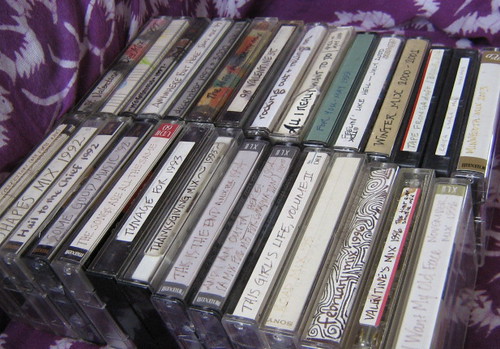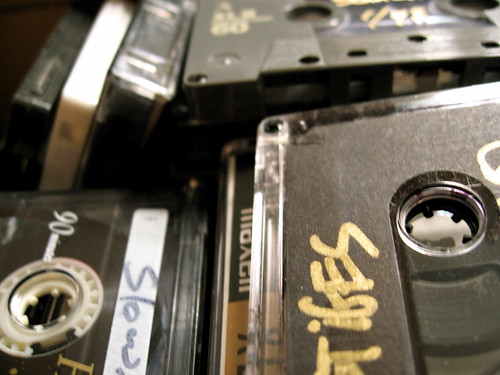Since then, I’ve received an e-mail from the company every. Single. Week. Normally, this would annoy my face off, as I generally trash any corporate ads without “FREE METS SEASON TICKETS FOR YOU, KRIS” plastered across the top. In this case, it would have been an awful mistake, like the AOL/Time Warner merger or hot pants.
Stunningly, eDiets' weekly missives are varied, educational, and even kinda fun. The best feature is undoubtedly the Food Hall of Shame, where readers submit their crazy-gross guilty pleasures (scrambled eggs and syrup, pickle and yogurt milkshake, etc.), but the healthy recipes always looked nice, too. I just never got around to trying one until this week. And you know what? Me like.
The first thing that struck me about Curried Sweet Potato Stew was the scent, since I began by sauteing a mirepoix with ginger and a bay leaf. After about twenty minutes, it assumes a fiery orange color, which definitely makes it one of the prettier meals on Earth. Finally, the taste enters the picture. It’s warming and exotic, with a touch of Thai in there (from the ginger and curry, I guess). For next time, I would double the lentils and add another cup of sweet potatoes for hardiness. The Boyfriend suggested reducing the liquid more and pouring over rice, and I could see that working well, too.
Yet, even without the alterations, this was a satisfying, thrifty late-Autumn meal, especially with a few Ritz thrown in for effect. All in all, a pleasant surprise, a lot like the eDiet e-mails themselves. Ahhh.
(NOTE: I don’t work for the company. Really. I swear.)
Curried Sweet Potato Stew
Makes 3 large, dinner-sized servings
Adapted from eDiets.
 2 tablespoons vegetable oil
2 tablespoons vegetable oil1/2 cup chopped onion
1/4 cup diced carrot
1/4 cup diced celery
1 Tbsp. fresh ginger, minced
1 bay leaf
pinch of red pepper flakes
1-1/2 cups peeled and cubed sweet potato
1 teaspoon curry powder
1/4 cup dry white wine
4 cups chicken or vegetable broth
1/2 cup canned diced tomatoes, undrained
1/4 cup brown lentils
1/4 cup chopped fresh cilantro
juice of 1/2 lemon
salt to taste
plain yogurt of sour cream (used light sour cream)
1) In a large pot or dutch oven, heat oil over medium-high heat. Add onion, carrot, celery, ginger, bay leaf, and red pepper flakes. Saute until veggies are soft, about 8 or 10 minutes. Add sweet potatoes and curry powder and saute 1 minute. Pour in wine and cook until nearly evaporated, stirring occasionally. Add broth, tomatoes, and lentils. Drop heat to medium and simmer about 30 minutes uncovered, until both lentils and sweet potatoes are cooked.
2) Remove pot from heat. Add lemon juice, salt, and half the cilantro. Serve, topped with sour cream and the rest of the cilantro.
Approximate Calories, Fat, and Price per Serving
408.3 calories, 14.8 g fat, $1.15
Calculations
1/2 cup onion: 24 calories, 0 g fat, $0.10
1/4 cup carrot: 13 calories, 0.1 g fat, $0.12
1/4 cup celery: 4 calories, 0 g fat, $0.15
1 Tbsp. fresh ginger: 5 calories, 0 g fat, $0.10
1 bay leaf: negligible fat and calories, $0.03
pinch of red pepper flakes: negligible fat and calories, $0.01
2 Tbsp. vegetable oil: 243 calories, 27.5 g fat, $0.04
1-1/2 cups sweet potato: 172 calories, 0.1 g fat, $0.55
1 tsp. curry powder: negligible fat and calories, $0.02
1/4 cup dry white wine: 48 calories, 0 g fat, $0.27
4 cups chicken broth: 346 calories, 11.5 g fat, $0.92
1/2 cup canned diced tomatoes: 25 calories, 0 g fat, $0.20
1/4 cup brown lentils: 271 calories, 0.8 g fat, $0.06
1/4 cup chopped fresh cilantro: 1 calorie, 0 g fat, $0.48
juice of 1/2 lemon: 6 calories, 0 g fat, $0.25
salt to taste: negligible fat and calories, $0.01
3 Dollops light sour cream: 67 calories, 4.5 g fat, $0.15
TOTAL: 1225 calories, 44.5 g fat, $3.46
PER SERVING (TOTAL/3): 408.3 calories, 14.8 g fat, $1.15





 7:23 AM
7:23 AM
 ari sari
ari sari

 Posted in:
Posted in: 


















